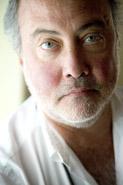Solving the myelin mystery
Neuroscientist David Colman is part of an innovative effort to find treatments for Multiple Sclerosis, funded and led by an American millionaire who has the disease.

David Colman, holder of the Penfield Chair in Neuroscience and director of the Montreal Neurological Institute
Claudio Calligaris
"Myelin looks almost crystalline when you see it under an electron microscope. It's striking that a cell could make something so incredibly regular and beautiful," says David Colman, holder of the Penfield Chair in Neuroscience and director of the Montreal Neurological Institute. The myelin sheath, wrapped around nerve axons in every vertebrate brain, works like the cladding on a fibre optic cable, accelerating the transmission of neurological impulses by permitting saltatory conduction; that is, instead of the impulse travelling in a straight line along the axon, it bounces along the myelin insulation, allowing for much faster conduction velocities. "Without myelin, the axon would have to be many times larger in order for our brains to perform the way they do; the human head would be as large as a 10-by-10 room. Myelin compacts the brain's functions into an area the size of a grapefruit."
But myelin isn't invincible, and sometimes the immune system goes askew and attacks it. Then the myelin breaks down, and the result is multiple sclerosis (MS) -- a condition that gets progressively worse as the sheaths are destroyed, reducing the ability of axons to carry neurological impulses, so that they simply peter out before reaching their destination. People with MS thus become easily fatigued and have diminished motor control.
Recently MS research has received innovative support from a new source. The Myelin Repair Foundation (MRF) is an innovative funding and support body founded in 2002 by Scott Johnson, an entrepreneur who made a fortune in the silicon revolution, and who was diagnosed with MS as a 20-year-old in 1976. Drawing on his own financial resources as well as those of other interested supporters, Johnson's initiative brings together five of North America's leading myelin repair researchers to form a group that will focus its energies on investigations that could have therapeutic consequences. Colman is one of the five, along with Ben Barres (Stanford), Robert Miller (Case Western), Stephen Miller (Northwestern), and Brian Popko (Chicago). The MRF insisted on a truly collaborative relationship, stipulating that the researchers work closely and share findings to help solve the riddle of regenerating myelin. There are precedents in nature. "If you cut the optic nerve of a goldfish or a frog, it will regenerate and re-myelinate," explains Colman. "But this will not happen in humans or any other mammal, and part of our research involves discovering why some organisms have this capacity and why higher organisms have lost it."
The MRF program has now been active for one year, and is already showing results. "The idea has worked remarkably well," says Colman. "There are experiments that have been in the back of my mind for maybe 10 years, but to gear up to do them when I had so many others as well was very difficult. But the MRF does the paperwork and the legal preparation, finds information and organizes the collaborations."
Currently, Colman is pursuing an idea that has been percolating for some time, and that has been given new relevance by the discovery by a fellow MRF researcher of a new protein in the myelin sheath. This protein exists only in small quantities, but is concentrated at regular points along the sheath. The MRF will help Colman's research team to investigate whether this protein has any role in myelin's breakdown. "It would have taken years to organize everything connected to this experiment on my own, but now it is happening in a matter of months, with the MRF's support," he says.
"The work is focused but not stifling," Colman stresses. "It allows the freedom to explore in a way that would be impossible when funded through traditional agencies or through drug companies." The collaborators meet regularly and the relationship is deepening. "But breakthroughs don't happen on a Tuesday," Colman notes. "I would never tell anyone that in five years we're going to have a cure, but I can say that in five years or less we will have new targets to test. We have a huge repository of knowledge, but it must be integrated and we have to test certain hypotheses that have come out of the acquisition of this knowledge." Time is still a necessary ingredient, of course -- but with high-level, focused collaboration, the process of discovery is faster than ever before.
